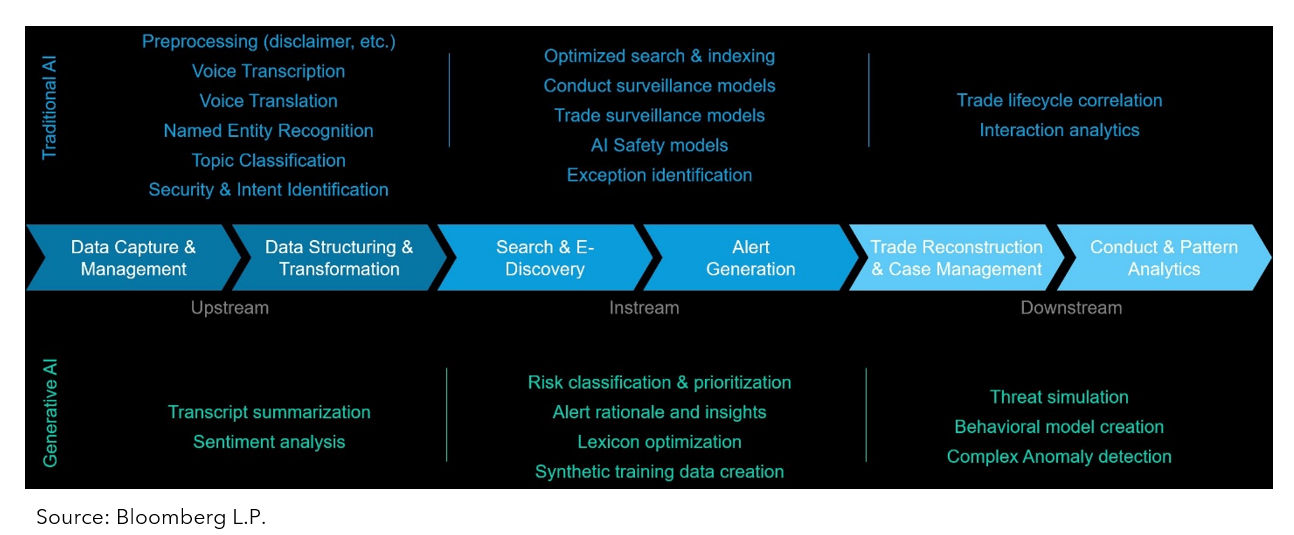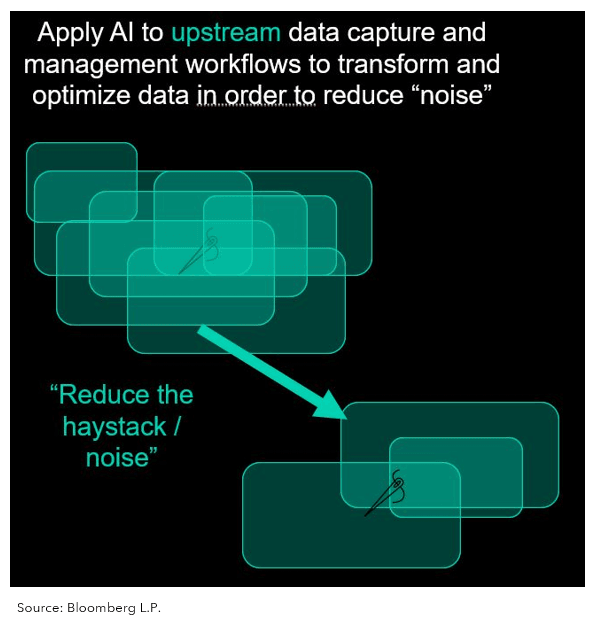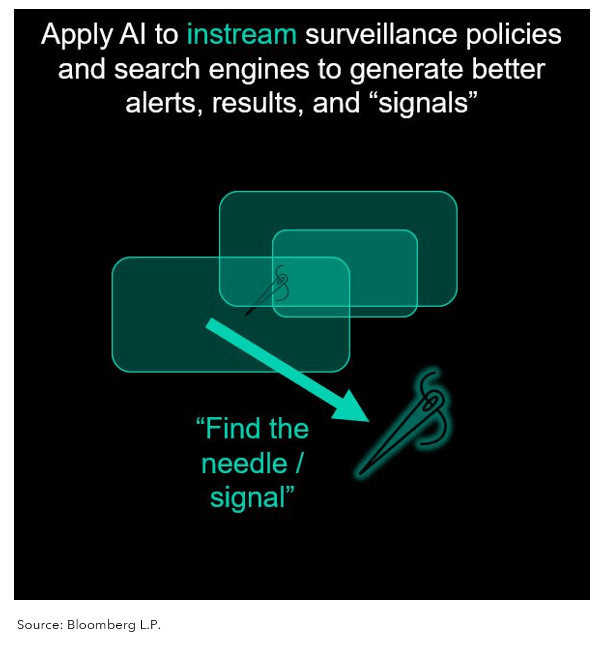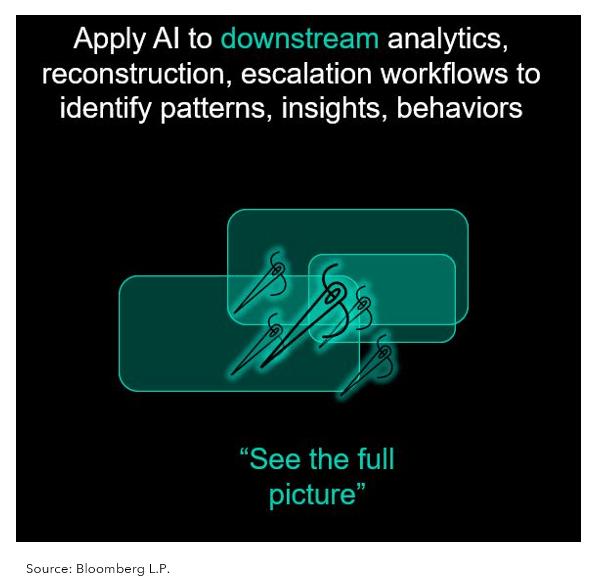ARTICLE
Navigating the future of AI in communications compliance

Bloomberg Professional Services
This article was written by Nader Shwayhat, Global Head of Compliance, Analytics, and Directory Solutions at Bloomberg.
As the volume and complexity of communications and data grow exponentially, financial institutions’ compliance teams face an immense challenge: maintaining oversight and ensuring adherence to ever-changing regulations. This environment signals a need to shift from reactive box-ticking compliance strategies to more proactive, predictive, and scalable ones.
PRODUCT MENTIONS
At the heart of this transformation lies Artificial Intelligence (AI), with which Bloomberg has been helping businesses reshape how they manage compliance. From monitoring vast volumes of electronic communications, such as emails, chats, Zoom calls, and WhatsApp messages to detecting nuanced behaviors, AI is being applied across a range of use cases.
The question isn’t, “Is AI going to transform compliance?” because it already has. Instead, the question is, “How can a firm use AI responsibly and effectively today?”
Traditional vs. generative AI: A practical application
The underlying concepts of AI are not new. The term “artificial intelligence” dates to 1956, and “machine learning” back to 1959. However, recent advancements, particularly in generative AI, have put powerful, accessible tools into the hands of businesses and consumers alike.
It’s crucial to understand that AI is not a singular technology but a diverse array of tools and techniques that, for compliance, have now fallen into two broad categories:
- Traditional: Traditional machine learning (ML) approaches to AI provide efficient, explainable models for tasks like entity and topic recognition, natural language processing (NLP), automated speech recognition, and sentiment analysis. In compliance, traditional AI is highly effective for classifying data (e.g., identifying a disclaimer), determining sentiment (e.g., positive / neutral / negative), or extracting specific information (e.g., tradable securities). A key advantage is their explainability: users can understand the data inputs, expected outputs, and how the model arrives at its conclusions, which is critical for regulatory scrutiny.
- Generative: Generative AI (GenAI) not only improves performance on tasks historically handled with traditional ML, but through developments such as large language models (LLMs) – which underpins ChatGPT for example – also excels at tasks like summarization and question answering that were previously difficult using traditional models. The relative creativity of GenAI allows these models to rapidly synthesize content across large datasets rapidly, making it suitable for tasks like transcript summarization, synthetic data creation, and regulatory change analysis.
While AI has incredible potential, it must also be deployed thoughtfully. After all, it is a technology, not a standalone solution. This means the focus should always be on solving specific problems rather than simply deploying AI for its own sake. That is why Bloomberg’s approach to AI in compliance is rooted in purpose and pragmatism.
AI in action: Enhancing compliance workflows
AI is already profoundly impacting various stages of the compliance workflow, from upstream data management to downstream analytics.

By equating a surveillance officer’s role in uncovering violations to finding the proverbial “needle in the haystack,” one can see how AI can be used in a variety of ways to reduce the noise (haystack) in poorly structured data to help better identify the true signals (needles) that can ultimately uncover the patterns and full picture that drive a firm’s conduct and market abuse risks.
1. Upstream data challenges – reducing the haystack
AI can optimize data capture and management processes by normalizing and transforming data before it is sent to a surveillance engine. Identifying market-related conversations (and filtering out those that are personal), removing disclaimers, ignoring news articles, and transcribing and translating audio are all prime examples of how AI can optimize communications and bring previously unstructured data into a format that helps reduce false positives. The transcription and translation engines offered by Bloomberg Vault as well as Bloomberg’s use of traditional AI models and LLMs for security identification and conversation classification are testaments to how AI can help optimize and pre-process data to reduce false positives.

2. In-stream surveillance and review workflows – finding the needles
The core of modern compliance monitoring lies in surveillance systems that trigger alerts based on communication patterns. Traditional lexicon-based tools, while still effective in certain ways, are being augmented with more advanced AI-based models that can detect subtle policy violations, nuanced behaviors, changes in tone, or patterns indicative of market abuse, insider trading, or conflicts of interest. This significantly enhances the quality of oversight and strengthens internal controls. AI can also help risk analyze, rationalize, and contextualize alerts, allowing teams to prioritize higher-risk cases and dramatically reduce the time and personnel costs associated with manual review.

3. Downstream analytics – seeing the full picture
AI can also be used to help combine and correlate data across unstructured communications and structured pricing and market signals to help firms see the full context around a particular trade or customer interaction. It can also conduct analytics based on current and past communication and trading patterns within the context of a user’s risk, role, customer, and organizational profile. Ultimately, it can help compliance officers better understand and optimize employee and client interactions, risks, and business opportunities through the additional context and insights it provides.

Building trust and transparency in AI policies
Trust and transparency are paramount for AI to be truly effective in a regulated environment. As such, Bloomberg recommends that firms utilize and deploy AI-based solutions with these core principles in mind:
1. Defined goals: Every AI solution should begin with clear, explainable objectives and preferably with specific goals and Key Performance Indicators (KPIs) in mind, including reductions in false positives, volumes of voice calls surveilled and identification of true positives.
2. Regulator-ready explainability: Detailed documentation should be provided to help clients understand the policy’s design and intended outcomes and are ready to share such documentation with auditors and regulators and that specific alerts can be explained and rationalized.
3. Consistent annotation: Annotation guides should be developed to improve consistency and accuracy across datasets used for training.
4. High-quality data sourcing: Data availability and quality challenges should be addressed through appropriate, high-quality datasets in which identifiers and inherent biases have been removed. Such datasets can be further optimized through close collaboration with internal and/or third-party subject matter experts and broadened through the use of LLMs, which are particularly good at creating additional synthetic data sets.
5. Rigorous testing and refinement: Like any technology, AI-based solutions should be released to early-adopter clients for direct feedback and continuous refinement through effective A / B testing that continually optimizes models over time.
6. Internal validation: A critical step is reverting to the firm’s initial metrics and goals to quickly identify, optimize, replace, and/or depreciate under-performing models.
Regardless of whether a firm is developing its own solutions, or choosing a trusted technology such as Bloomberg Vault, this approach is designed to help AI-based compliance solution(s) to withstand scrutiny, allowing compliance officers to confidently explain what their models do, how they were trained, and how their repeatable outputs have met the firm’s goals.
The future is collaborative
Integrating AI into compliance is not about replacing human professionals but empowering them to be more effective at protecting their firms. AI enhances human oversight, reduces blind spots, and enables smarter, faster decisions. As this journey continues, collaboration between financial firms and technology providers will be key to addressing emerging challenges and developing policies for new risk areas, such as market abuse, off-channel communications, and detecting behavioral changes in communication patterns. The future of compliance is intertwined with AI and promises a more efficient, accurate, and proactive regulatory surveillance landscape.
How can we help?
Looking for solutions to elevate your business controls, manage your conduct risk and meet regulatory obligations?
Bloomberg Vault provides a suite of highly secure solutions for capturing, archiving, surveilling, reconstructing and analyzing all of a firm’s trades and communications, allowing companies to elevate their business controls, manage their conduct risk and meet their regulatory obligations in today’s highly dynamic environment where channels, venues and regulations are constantly evolving and expanding.
E-communications archive
Bloomberg Vault delivers write-once, read-many (WORM) storage across your firm’s monitored e-communication channels for any data retention period you select up to 30 years.
E-communications surveillance
Apply out-of-the box policies in real time, customize policies to reduce false positives and meet regulatory and data security needs, and create complex policies with our powerful query language and syntax capability.
Search and e-discovery
Use our case management tools and flexible data exporting capabilities to quickly locate, compile and analyze your records, expediting regulatory audits and legal investigations.
Trade archive and reconstruction
View trade records from multiple order management systems in a single consolidated view, gaining visibility into a trade’s complete lifecycle, when you pair your trade archive solution with Bloomberg Vault.
Administrative and preventative controls
Safeguard information from inappropriate access and misuse with our powerful community governance tools, which help you oversee users, groups, chat rooms and policies in real time.
Learn more about Bloomberg Vault here.